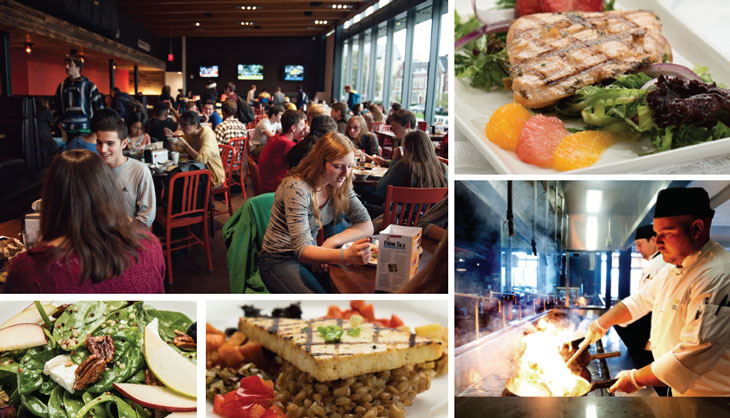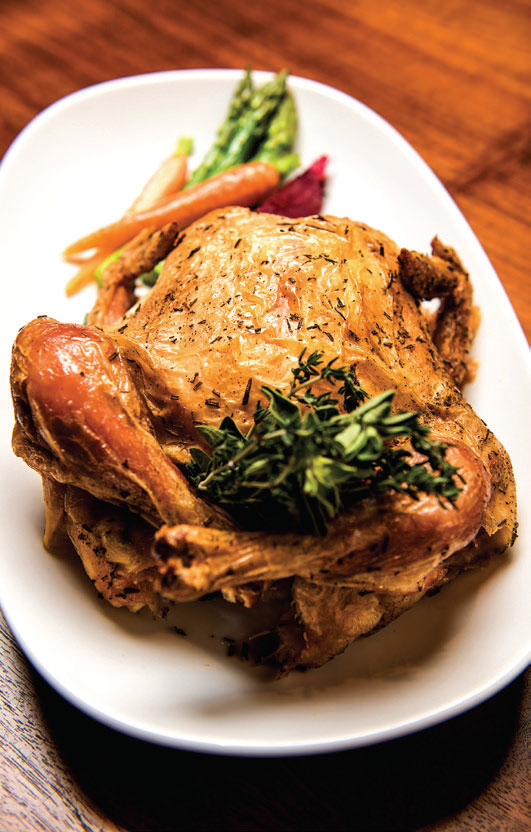From nutritious quinoa and kale to pulled pork and pasta, a tour of U-M’s dining halls and cafés reveals not just sustainable local practices, but sophisticated student palates.
When the newly renovated South Quad reopened in fall 2014, visitors were quick to tweet out tributes, one even asking facetiously, “Is this a new Google campus or a residence hall?” The excitement didn’t stem from the updated bathrooms and new hall fixtures, but from the state-of-the-art dining area. More than 100,000 square feet of stylish space is outfitted with everything from chairs made of recycled Coca-Cola bottles to communal tables constructed from wooden bowling lanes.
But the biggest transformation was culinary — 10 micro-restaurants, bearing such evocative names as Wild Fire, Two Oceans, Finale, and Smoke. The food is as beautifully presented and colorful as the décor — metallic tiles, cool lighting, and shiny chrome reflecting each station’s food theme.
For alumni old enough to remember the days when U-M’s meal plan consisted mostly of mac and cheese, mystery meats, gloppy casseroles, and burgers with fries, today’s residence hall food is distinctively different. Call it gastronomic grub. One of the few recognizable dishes from the past is the ever-popular chicken broccoli bake, which has earned a Facebook page to let students know when and where on campus it is being served. In contrast, today’s student dinner menus read more like a global food tour — tempeh Vietnamese chili stir fry, Grecian pita fold, English toad-in-the-hole, Texas French toast, and Moroccan vegetable stew.

Steve Mangan, director of Michigan Dining, says the offerings now available in the seven residential dining halls on campus (which together serve an estimated 4 million meals a year) “now rival the best restaurants in town.” On any given night, one can find students lined up at stir-fry stations and pasta bars, eager to choose which protein, vegetable, grain, and sauce they want prepared. Made-to-order deli sandwiches and gourmet salads piled high with locally sourced vegetables, meats, and cheeses are also available, as is the daily array of international entrees.
“This is my first time having mussels,” said freshman Shelby Stadler one evening last winter as she dipped her fork into a steaming bowl of shells immersed in a fragrant broth. Her dining companion at South Quad was fellow freshman Jocelyn Rice, who had chosen the chicken tamale with a verde sauce nestled in black beans. After removing it from the corn husk, she tried a bite. “It’s delicious,” she commented, sounding mildly surprised.
“So is mine,” said Stadler, equally bemused. “What is so great is we have exposure to food here we would never have at home.”
That is precisely Mangan’s goal. “Our job is to merge academics with the social, lifestyle piece. We want to teach the students about wellness and fitness, nutrition, sustainability, and eating right. Basically, we want to create healthy habits in them before they leave us.”
Most impressive is how Michigan Dining can now accommodate students with special dietary needs and restrictions. Given that 560 students — or approximately 6 percent of 9,000 on the meal plan — have some type of food allergy, careful labeling is of particular importance. Menus posted at each dining hall indicate which dishes are vegan, gluten-free, nut-free, halal, and even “M Healthy,” meaning they are low in sodium, sugar, and fat. Both South Quad and Bursley dining halls now have access-controlled gluten-free pantries to reduce the risk of cross-contamination. Additionally, all ingredients and calorie counts are provided via a database for nearly all of U-M’s 10,000 recipes, allowing consumers to track every morsel that might enter their mouths.
“Our job is to merge academics with the social, lifestyle piece. We want to teach the students about wellness and fitness, nutrition, sustainability, and eating right.”
Were it not for the small plates of perfectly proportioned food groups being served, one could easily wonder whether U-M’s new unlimited meal plan policy might result in a “larger” student body. But the tapas-sized servings, combined with a lack of cafeteria trays, are all part of a new dining system meant to encourage students with bigger appetites to return for more and students with smaller ones to waste less.

Michigan Dining is not only responsible for the food in the residential halls and most University catered events, it also operates more than two dozen markets and retail cafes located across the Ann Arbor campus. Consisting of 225 kitchen cleaners and food service workers and 180 temporary workers, and offering roughly 1,000 jobs to students each term, it is not only one of the nation’s largest higher-education dining operations, it is also an award-winning enterprise.
Last year, South Quad won the grand prize and gold award for residential dining concepts at a large school from the National Association of College and University Food Services (NACUFS), a top honor among the more than 70 colleges and universities across North America that competed for awards in various categories. Michigan Dining also earned the NACUFS top retail prize for the Fireside Café in Pierpont Commons on North Campus, which serves a changing menu of healthy hot items alongside street food from local eateries.
Additionally, Michigan Dining was the first department to have all of its facilities achieve the University’s platinum-level certification for sustainability, while Twigs dining hall in the Oxford residential neighborhood also achieved a two-star certified rating from the Green Restaurant Association, a national nonprofit. Certification for both includes recycling and composting, low energy consumption, and an emphasis on local procurement. The latter is one of Michigan Dining’s strongest initiatives. Out of its annual $11 million food budget, 27 percent is now spent with Michigan farms and companies. All dairy comes from Michigan farms within 100 miles of campus, and most of the meat is supplied by local sources less than 250 miles from Ann Arbor.
To fully appreciate how far U-M dining has come, Amir Baghdadchi, ’98, communications director for University Housing, recalled his student days when he worked in the Couzens dining hall.
“In my time, the game was to load your tray up with as many things as you possibly could in one sitting: seven glasses of milk, a mountain of tater tots, and some item like Eggs McMichigan, which was hugely popular though no one knew exactly what it was and I can only assume there was some worry about copyright infringement,” he recalls. “Dining hall food back then was meant to mimic a really institutional church supper. Now the students get red mullet. Not because they are miniature Roman emperors, but because it is a healthy choice and they want sustainable fish.”

Frank Turchan, Michigan Dining’s executive chef, is the first to credit the students with the food changes that have taken place. “Five years ago, some students called me out for serving unsustainable fish,” recalls Turchan, who now partners with Sea to Table, an organization that connects fisheries with chefs nationwide. As a result, U-M is the first Big Ten university to be certified by the Marine Stewardship Council. Turchan — who, along with Mangan, is a graduate of the Culinary Institute of America — joined U-M just as the dining halls were beginning to be renovated seven years ago. Not only did he oversee the renovations for Hill Dining, located in Mosher Jordan, as well as the updates in East Quad and South Quad, but he also helped design the kitchen and eating spaces at North Quad.
Turchan’s colleague Nelson “Buzz” Cummings, the chef de cuisine at East Quad, remembers back to 2006 when students asked the University to implement a fair-trade organic coffee policy across campus. “These kids are smart and care about agriculture and the environment,” says Cummings, who was an early advocate for procuring farm-to-table ingredients at East Quad.
Lindsay Haas, the department’s culinary and nutrition support specialist, also fields requests from students, though they do not always like her answers. “The California kids are always asking me why we don’t have avocados in February. I then have to explain Michigan’s shorter growing season to them,” she explains, laughing.
“In my time, the game was to load your tray up with as many things as you possibly could in one sitting: seven glasses of milk, a mountain of tater tots, and some item like Eggs McMichigan.”
Keith Soster, director of student engagement for Michigan Dining, sees firsthand how passionate the students are about issues like “pre-consumer composting” (composting food waste in the preparation process, which Michigan Dining now does in all the residential halls). Soster’s work includes partnering with Michigan farmers and the food community in the region, as well as coordinating with the many student organizations and classes that have dining-related ventures. “Right now, we have 68 student projects. They love working on sustainability projects like our two-acre campus farm at Matthaei Botanical Gardens.”
Like Soster, Haas’ role as Michigan Dining’s nutritionist is multifaceted. Not only does she met individually with students in search of dietary advice, she also vets new recipes and makes sure the database of ingredients is up to date. “We’re always trying to do things better and have a wide variety in our offerings,” says Haas, adding that she sometimes sends a new recipe back to a chef to make it healthier.
For those worried this new emphasis on dining is just another expense in the amenities arms race affecting the cost of higher-education, Turchan says there is great value in their meal plan, particularly as it is unlimited. He estimates each dining hall meal costs students about $3.25. Baghdadchi agrees, but adds there is more to it than simply filling the community’s stomachs with fabulous flavors.
“It is not that we are simply slaves to our taste buds. It is that when we look at a piece of meat, we now think, ‘How did it get there? How much meat makes sense on my plate based on its carbon footprint? How much energy did it take to grow this? How much to get rid of it if we waste it?’ In the old days, we took food for granted. Now we know it has a story behind it, and that is an education in itself.”

Food for Thought Around Campus
Given that the public is welcome to eat in any of the dining halls and at the many campus cafes, here is a roundup of the best culinary — and community-driven — items to sample around campus.
EAST QUAD
This residence hall’s long-standing reputation as a bastion for U-M’s vegetarian/vegan set remains to this day. Meatless Mondays feature hearty items like eggplant etouffee, Tex-Mex chili, and parmesan- encrusted tilapia. But don’t miss the flavorful gelato bar (mocha, pistachio, and caramel), courtesy of Prairie Farms, a Michigan dairy.
SOUTH QUAD
Meat eaters head here any night of the week and straight to the “smoke” station (closed during lunch as the meat has to smoke all day). One recent mouth-watering entrée was a smoked creole chicken served with sautéed kale and a side of plantains with leeks, herbs, and pecans.
THE FIRESIDE CAFÉ
In Pierpont Commons on North Campus – On a blustery day, visit The Hearth, one of the food stations in the Fireside Cafe. For only $8, you get an entrée and two sides (such as grilled salmon with potatoes and roasted vegetables) or one of the Italian pies fired up in the pizza oven. Groups of five or more can even reserve in advance, as tables go fast at those nearest to the fireplaces. With flat screen TVs and comfy furniture, it feels like home.
FIELDS CAFÉ
In Palmer Commons – This casual, farm-to-table restaurant features handcrafted food made from fresh, locally and sustainably sourced ingredients, including (when in season) produce from U-M’s student-run Campus Farm at Matthaei Botanical Gardens. Spinach, Cobb, and kale salads are served along with everything from a chicken shwarma to a beet sandwich.
Prices in the residential dining halls for adults range from $8.25 to $14.75, depending on the time of day (breakfast, lunch, or dinner). Children under 6 eat for free, and those between ages 6 and 10 pay between $6.25 and $10.75. Credit cards are only accepted.
Jennifer Conlin, ’83, is the deputy editor of Michigan Alumnus.





